Although there was much more to see around Lisbon, it was Friday so it was time to move on. We found our way along the metro to the bus station and booked our tickets to Estremoz.
Estremoz is a very small town in the Alentejo region of Portugal, that is, the south central region of Portugal that borders Spain to the east and the Algarve to the south. "Alentejo" means "beyond" and refers to the area beyond Lisbon and the Tagus river. It is an extremely beautiful area, especially for a Saskatchewan boy who has been dealing with the crowds of Lisbon. Rolling hills, fields surrounded by stone walls, farmhouses with white walls and courtyards and grassland dotted with cork trees. Open space but with lots to gaze upon too.
I didn't get the history of it, but Estremoz must have lots and lots of marble nearby. The entire town is beautiful, pink marble. The cobblestone sidewalks are small pieces of pink marble. The curbs are small slabs of marble. Heck, the bus station is all marble! Harbour Landing homeowners would be seeing kitchen countertops at every intersection.
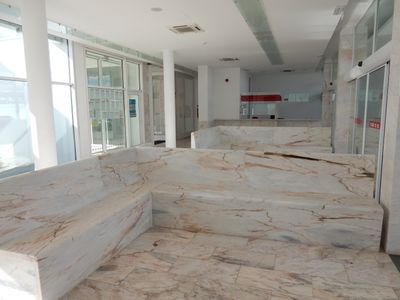
Marble Bus Depot, Estremoz
Estremoz is a compact town on top of a hill with great views of the surrounding farmland. And what does one put on top of a hill with great views of the surrounding territory? A castle, of course! Estremoz castle isn't as big as Castelo Palmela, but it's got all one needs; narrow, winding streets weaving their way up to the castle, walls surrounding the castle and church with a nice walking path around most of the hill, and a gorgeous set of steps down to the town centre.
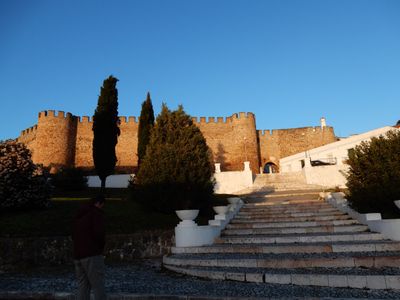
Most of the castle and church has been turned into a pousada, a state run hotel and restaurant complex for people much wealthier than I. Many of the castles and churches in the country have been converted to pousadas in order to fund their upkeep. It's certainly a different way to see the country than our Airbnb apartments and guest houses. I don't begrudge the wealthy their comforts, because the pousadas were nice to look at on our way to the town square and our modest room for the night.
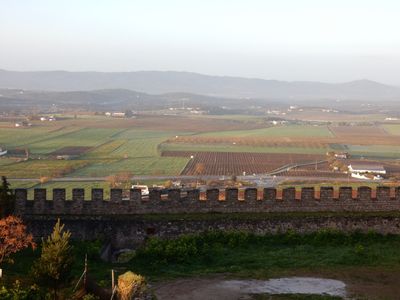
We booked a room at the Hotel O Gahdana, a two star hotel just off the main square which was recommended in Cindy's guide book. At 40€ for the night it was a tiny splurge but was well worth it. It was a mansion compared to our tiny flat in Lisbon; wide hallway, spacious room and a shower that let me stand upright. And the staff were amazing. Only the night supervisor spoke any English, but we listened hard, played a bit of charades and worked everything out with the day crew.
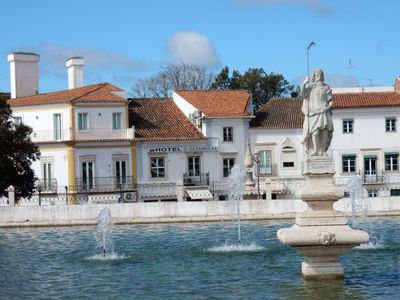
Imagine getting off the bus, crossing the square, and realizing there is your hotel. Wonderful!
We also got to play charades at the tiny restaurant down the street where we went for supper. We held out till 7:30PM but were still the first customers of the night, although the five other tables filled up soon after. We did our best to navigate the Portuguese menu; Cindy knew she was getting fish and I knew I ordered pork, but beyond that we had no idea. It didn't matter. Both plates were huge and delicious. Two big plates, plus bread and wine, plus the desert of the house (which was delicious) for under 25€. Incredible. I'm pretty sure a 1/2 litre of local wine was 3€, which is so cheap I wish I could handle a litre.
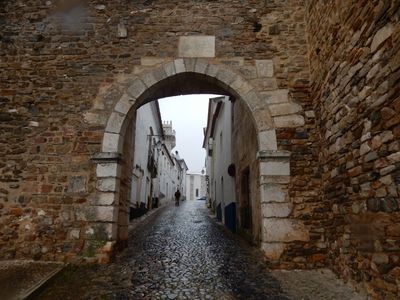
But, the real reason we came to Estremoz wasn't for the castle, or the wine. It was for the market! Each Saturday, Estremoz is home to one of the largest farmer's markets in all of Portugal. Cindy set an alarm for this one. We weren't going to miss it.
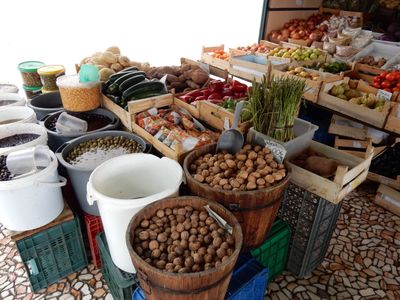
Now you have to remember, early March is still late winter in Portugal. There's not much on offer, or so they told us. But I'll tell you what, there was more selection at the Estremoz market than most Regina farmers markets. Huge bins of oranges, lemons, potatoes, carrots, almonds, hazelnuts and walnuts. Strawberries! Peppers! Winter squash so big that they sold them buy the chunk. One fellow even had a basket of huge avocados from his two trees.

There were baskets of eggs that you could pick out and put in the carton yourself. Some grandmas just sat on a bench with a basket of eggs to sell. They didn't even need a stall.
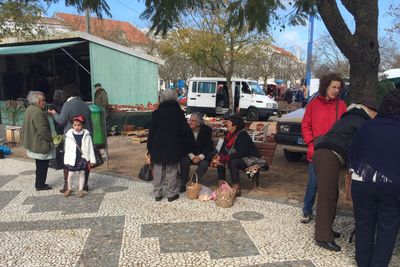
There were several stands selling local sausages and cheese. One fellow had large slabs of pork fat and was cutting chunks for the ladies to take home.
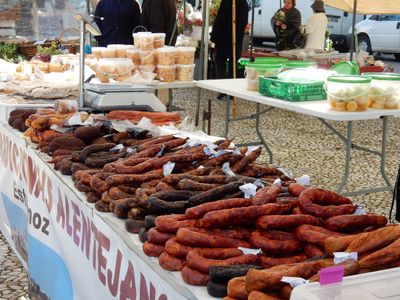

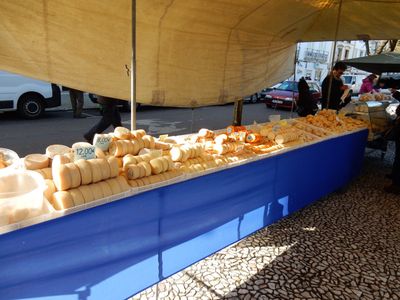
And some of it was live! There was a row of sellers with chickens, ducks, geese and rabbits in cages. We learned this is prime rabbit season and were a little scared of one old gentleman who gave his rabbit a good looking over before agreeing to take him home. I thought he was going to ring its neck right then and there. Over the course of the morning dozens of people took their Sunday dinner home in a cardboard box with airholes cut out.
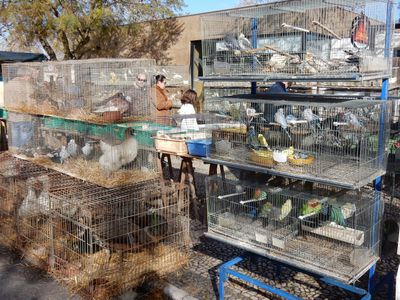
Midway through the morning, we got another treat. There was an off-road racing event just out of town, so all the trucks in the event held a parade through town. Three laps of honour around the square. I thought it was an incredible racket, but lots of the old fellows stopped to have a look. (In the afternoon, there was a second parade of muddy trucks, but not near as many people stayed to see that one.)
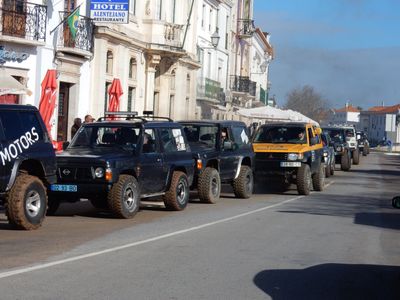
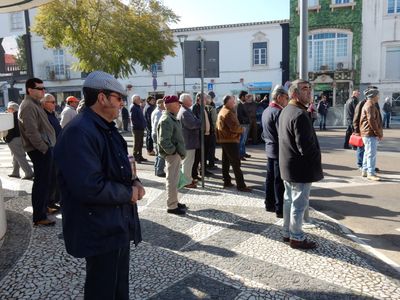
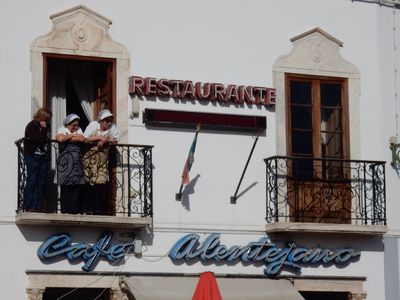
It wasn't just the fellows watching the trucks!
We discovered our new favourite market snack. It's called Fartura and is the Portuguese version of a churro, or beaver tail, or elephant ear. Fried dough in sugar. What could be better?
There were two Fartura stands. One run by an old couple (Sir fried the dough while Madam mixed the batter, portioned out the Fartura and took the money.) This booth had a line all day long. We waited 10 minutes and we were lucky. The other stand was run by a young man and I never saw a single person go to that stand. There's an interesting story there but my Portuguese isn't strong enough to get the scoop.
The unique trick to Fartura is the batter is squeezed out in a continuous, circular spiral, flipped as a single unit, then cut (by madam) into long sticks and then rolled in cinnamon and sugar. Two sticks made up one portion and most people bought two or three portions to take home. We tucked into ours before we had even left the line. Delicious!
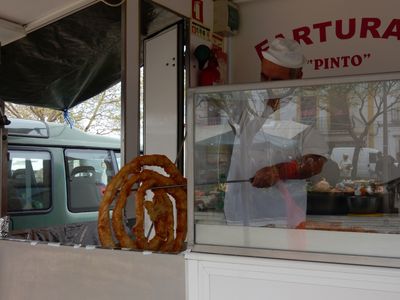
There was so much more to the market. One seller specialized in pet birds, from tiny chickadees to peacocks. There were many plant growers selling bedding plants (they'd pull 20 plugs of lettuce or carrot or tomato seedlings, put them all in a plastic bag and sell them for 1€) and fruit trees. I would've bought an orange tree for 7.50€ but it wouldn't fit in my suitcase.
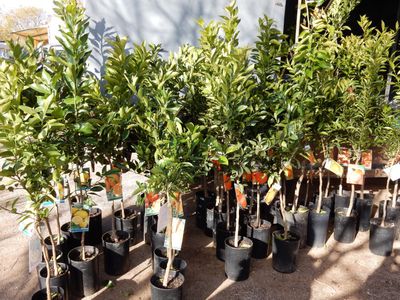
And finally, beside the farmer's market was a flea market; row after row of antiques, used books, pottery and clothes. There was even a man selling a table full of Russian cameras and Soviet military hats.
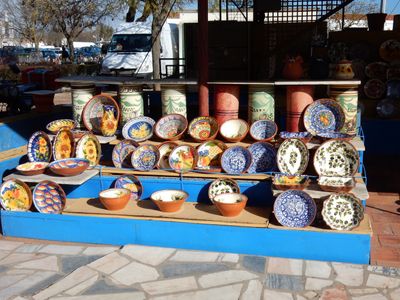
But my favourite sellers, bar none, were the three young girls selling cake by the slice. They had baked three cakes at home and had them displayed on a wooden table. For 1€, you got a slice of the cake of your choice, cut to order and wrapped in a napkin. The Regina health inspector would pass a large stone at the thought, but I'll tell you what, we put the paper wrapped cake in Cindy's pack and ate it a day or so later. I'm still able to write about it and never even got the shakes.
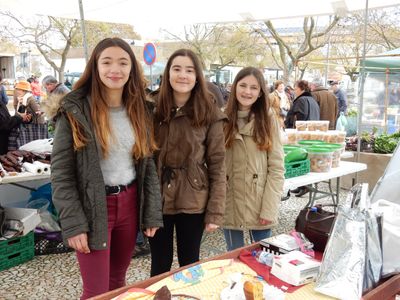
By around 12:30 it had started to rain, so all the sellers packed up and headed to the bars, pastelarias and snack bars around the square for a drink and bite to eat. We ducked into a pastelaria too, for coffee, hot chocolate, a pastry and a box of cookies for the afternoon bus to Evora. It's only a one hour ride, but you can never be too prepared. Emergency cookies are an important component of every traveler's kit.
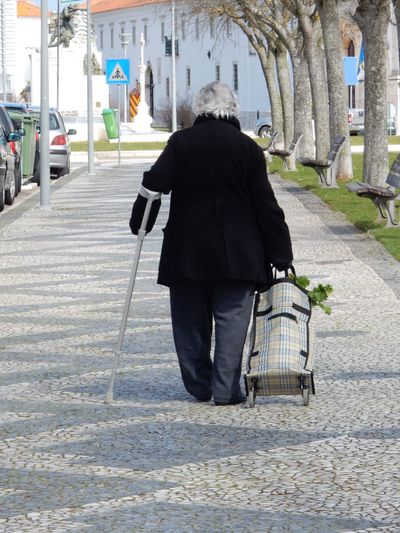
Good day at the market!
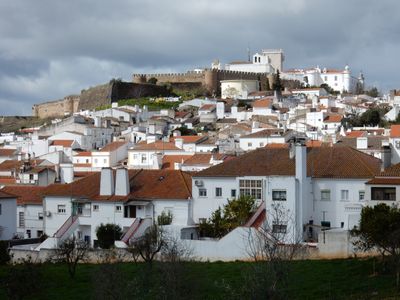
Farewell Estremoz. Already one of our favourite places.